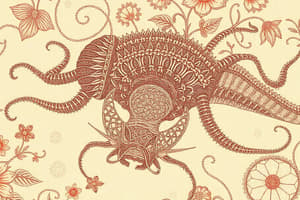Podcast
Questions and Answers
What is the primary cause of genetic variation within a population?
What is the primary cause of genetic variation within a population?
- Natural selection
- Environmental factors
- Phenotypic changes
- Germ-line mutations (correct)
Which of the following factors can act as selective forces in natural selection?
Which of the following factors can act as selective forces in natural selection?
- Reproductive isolation
- Population size
- Climatic factors (correct)
- Genetic mutations
Natural selection has a specific goal to produce perfectly adapted organisms.
Natural selection has a specific goal to produce perfectly adapted organisms.
False (B)
Individuals with favourable phenotypic characteristics are less likely to reproduce successfully.
Individuals with favourable phenotypic characteristics are less likely to reproduce successfully.
Name one mechanism that causes genetic variation apart from germ-line mutations.
Name one mechanism that causes genetic variation apart from germ-line mutations.
Sexual reproduction results in formations of new combinations of __________.
Sexual reproduction results in formations of new combinations of __________.
What is the impact of industrialization on the peppered moth population?
What is the impact of industrialization on the peppered moth population?
Natural selection acts on _______ variation in a population.
Natural selection acts on _______ variation in a population.
Match the following concepts with their descriptions:
Match the following concepts with their descriptions:
Match the following species to their selective pressures:
Match the following species to their selective pressures:
Which of the following is a factor that can lead to differential survival and reproduction?
Which of the following is a factor that can lead to differential survival and reproduction?
What is an effect of environmental changes on phenotypic characteristics?
What is an effect of environmental changes on phenotypic characteristics?
Offspring phenotypes are always identical to their parents due to genetic inheritance.
Offspring phenotypes are always identical to their parents due to genetic inheritance.
Name one mechanism of natural selection.
Name one mechanism of natural selection.
What outcome results from a variety of genotypes formed in the offspring?
What outcome results from a variety of genotypes formed in the offspring?
Only genetic mutations contribute to genetic variation.
Only genetic mutations contribute to genetic variation.
What was a significant consequence of the extinction of dinosaurs?
What was a significant consequence of the extinction of dinosaurs?
Mass extinction events can occur simultaneously across many lineages.
Mass extinction events can occur simultaneously across many lineages.
What is one trend seen in macroevolution according to the provided content?
What is one trend seen in macroevolution according to the provided content?
Evolving from marine habitats to _______ habitats is one pattern seen in the tree of life.
Evolving from marine habitats to _______ habitats is one pattern seen in the tree of life.
Match the following trends with their descriptions:
Match the following trends with their descriptions:
What factor is primarily responsible for leaving ecological niches empty for mammals after the dinosaurs' extinction?
What factor is primarily responsible for leaving ecological niches empty for mammals after the dinosaurs' extinction?
Flashcards are hidden until you start studying
Study Notes
Selective Forces and Natural Selection
- Environmental pressures such as competition, predation, climatic factors, disease, and parasitism shape phenotypic adaptation.
- Differential reproduction occurs when individuals with advantageous traits have a higher reproductive success.
- Favourable phenotypic traits lead to increased fitness and successful reproduction, while unfavourable traits decrease reproductive success.
Example: Peppered Moth (Biston betularia)
- Before the industrial revolution, light-colored moths blended with tree bark, making them less visible to predators.
- Dark-colored variants were easily spotted by predators, leading to lower survival rates.
- Post-industrial revolution, pollution darkened tree bark, favoured darker moths, which became less predatory targets.
- With modern air pollution controls, lighter moths are favoured again as tree lichen returns, causing dark variants to become rarer.
Mechanisms of Evolution
- No species is perfectly adapted; natural selection is a mechanical process without specific goals.
- Genetic variation within populations is crucial for natural selection to operate effectively.
Sources of Genetic Variation
- Germ-line mutations are the primary source of genetic variation.
- Other sources include gene duplication, chromosomal swaps, and duplications or deletions of whole chromosomes.
- Sexual reproduction results in new combinations of alleles, contributing to diverse offspring genotypes.
Phenotypic Differences in Offspring
- Offspring phenotypes differ from parents due to genetic variation and environmental influences.
- This process leads to a wide array of phenotypes, enhancing adaptability to changing conditions.
Evolutionary Diversification
- Rapid diversification followed the extinction of dinosaurs, filling ecological niches left available by climatic changes.
- Mammalian evolution increased significantly during this period, showcasing how environmental shifts prompt evolutionary changes.
Extinction Patterns
- Extinction occurs frequently within lineages, affecting either individual lineages or causing mass extinctions across multiple lineages.
- Each lineage has an inherent risk of extinction, shaping the evolutionary tree of life.
Trends in Macroevolution
- Evolution showcases increasing complexity from simple prokaryotic life to advanced eukaryotic organisms.
- Development of more complex societies, larger body sizes, and enhanced cranial capacities characterize evolutionary trends.
- Transition from marine habitats to terrestrial and aerial environments marks significant ecological adaptations.
Studying That Suits You
Use AI to generate personalized quizzes and flashcards to suit your learning preferences.




